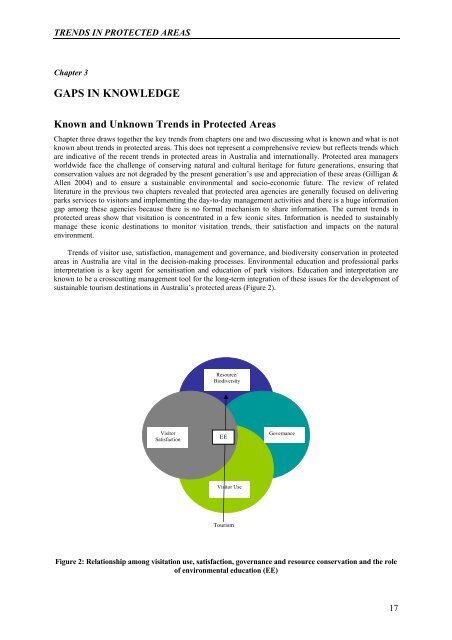TRENDS IN PROTECTED AREAS - Sustainable Tourism CRC
TRENDS IN PROTECTED AREAS - Sustainable Tourism CRC
TRENDS IN PROTECTED AREAS - Sustainable Tourism CRC
You also want an ePaper? Increase the reach of your titles
YUMPU automatically turns print PDFs into web optimized ePapers that Google loves.
<strong>TRENDS</strong> <strong>IN</strong> <strong>PROTECTED</strong> <strong>AREAS</strong><br />
Chapter 3<br />
GAPS <strong>IN</strong> KNOWLEDGE<br />
Known and Unknown Trends in Protected Areas<br />
Chapter three draws together the key trends from chapters one and two discussing what is known and what is not<br />
known about trends in protected areas. This does not represent a comprehensive review but reflects trends which<br />
are indicative of the recent trends in protected areas in Australia and internationally. Protected area managers<br />
worldwide face the challenge of conserving natural and cultural heritage for future generations, ensuring that<br />
conservation values are not degraded by the present generation’s use and appreciation of these areas (Gilligan &<br />
Allen 2004) and to ensure a sustainable environmental and socio-economic future. The review of related<br />
literature in the previous two chapters revealed that protected area agencies are generally focused on delivering<br />
parks services to visitors and implementing the day-to-day management activities and there is a huge information<br />
gap among these agencies because there is no formal mechanism to share information. The current trends in<br />
protected areas show that visitation is concentrated in a few iconic sites. Information is needed to sustainably<br />
manage these iconic destinations to monitor visitation trends, their satisfaction and impacts on the natural<br />
environment.<br />
Trends of visitor use, satisfaction, management and governance, and biodiversity conservation in protected<br />
areas in Australia are vital in the decision-making processes. Environmental education and professional parks<br />
interpretation is a key agent for sensitisation and education of park visitors. Education and interpretation are<br />
known to be a crosscutting management tool for the long-term integration of these issues for the development of<br />
sustainable tourism destinations in Australia’s protected areas (Figure 2).<br />
Visitor<br />
Satisfaction<br />
Resource/<br />
Biodiversity<br />
EE<br />
Visitor Use<br />
<strong>Tourism</strong><br />
Governance<br />
Figure 2: Relationship among visitation use, satisfaction, governance and resource conservation and the role<br />
of environmental education (EE)<br />
17











